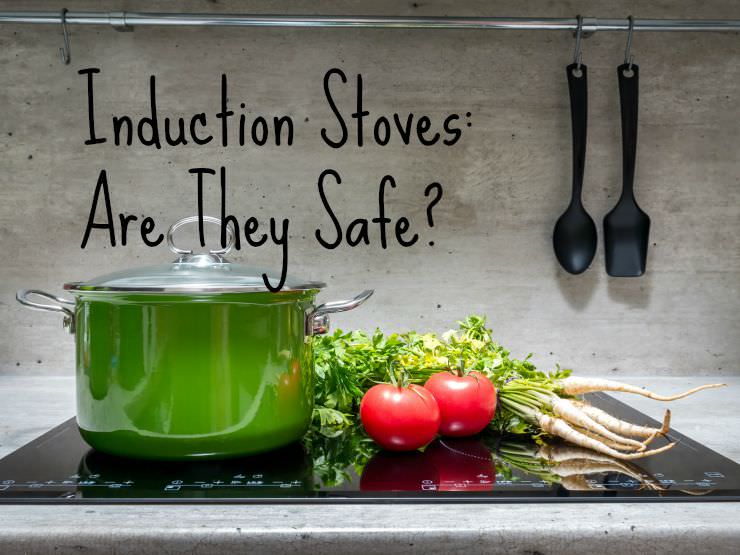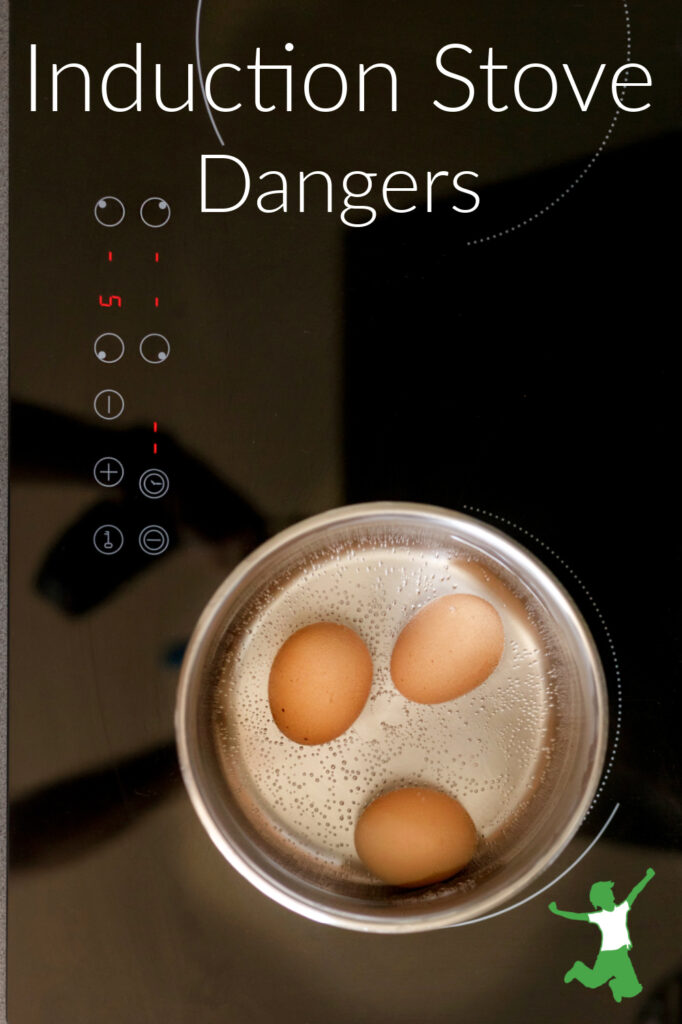The important reasons why bringing an induction stove into your home should be approached with caution as this technology is a source of excessive EMF toxicity as confirmed by scientific study. Even induction stove user manuals warn against standing too close!

Buying a kitchen stove is a rare purchase most people make only a few times in a lifetime. Currently, the trend toward replacing electric cooktops with an induction stove is quite popular. Is this a wise purchase? Let’s take a look …
In our home, we purchased a glass top stove in 1997 when we completely remodeled the (very old) kitchen. At that time, the range we selected boasted the latest and greatest technology which included a glass top cooking surface.
We were upgrading from a tiny 1950’s stove (see hilarious picture below) that while it seemed to fit very well with the orange, 1970s style wallpaper, fake butcher block countertops and canary yellow cabinets (no kidding), it was not something we regretted replacing!
While this new range was awesome (so nice not to have to clean up messes under coil burners anymore!) and has served us well for many years, it recently came time to replace it when problems developed.
Induction, Gas or Electric?
Since we had upgraded to the best technology many years earlier with good results, we thought we should probably do so again. This involved the purchase of an induction stove with all the bells and whistles. The upgrade hopefully would make my many hours spent in the kitchen even more efficient.

Since indoor air-polluting gas stoves were thankfully not an option for our neighborhood, electric was our only choice. We made the rounds to Best Buy, Home Depot, and online to see what was available.
We eventually settled on a stainless steel induction stove. It offered nearly all the latest technology of the (amazing but ridiculously expensive) Viking stoves that celebrity chefs use but with a much more reasonable price tag.
This is the induction stove we originally picked that thankfully, we never bought (we bought this one instead).
I particularly liked the extra-large knobs and oversized glass top that prevented spills from trickling down the crack between the stove and the countertop. It was exactly what I was looking for.
We also decided to get the matching convection oven (that also functions as a toaster) to replace our old microwave oven that I only ever used for storage anyway.
Little Known Dangers of an Induction Stove
Really excited about our upcoming purchase, I posted about it on social media to see if anyone had any further input.
Right away, a couple of comments got my attention.
Jeanette K. said, “My mother’s induction stove was measured by EMF professionals and had extreme readings.”
In addition, Beth H. warned that “The only downfall [with an induction stove] is that you have to use pans that magnets can stick to”.
EMF Risks?
So glad I asked for the input! Neither of these concerns about induction stoves was mentioned by the salespeople I spoke to or the marketing material I had reviewed.
Since I frequently cook with glass, having to only use pans that magnets can stick to would be a serious downside.
It would require purchase of a few pieces of new cookware and bakeware which I really didn’t want or need.
But, it was Jeanette’s comment about the EMF dangers of an induction stove that really gave me pause. EMF overexposure is a huge concern of mine that I’ve written many articles about.
We take great pains in our home to minimize excessive EMF exposure such as turning off wifi at night, using radiation canceling cases and headsets for our cellphones, and EMF shields for our PCs and notebooks.
I also avoid dirty electricity in our home by never using dimmer switches, fluorescent, or LED bulbs.
In addition, we use battery power for our electronics as much as possible. Higher EMF exposure occurs when you use a laptop while it is plugged in, for example.
Induction Technology Emits Strong Magnetic Fields
When I started examining the technology behind an induction stove, I was more than a little shocked and incredibly grateful Jeanette had commented about it to clue me in to do further research. Here’s what I found out:
The technology of an induction stove works by alternating magnetic fields that generate heat in a cooking vessel made of ferrous metals. The benefits of induction cooking as opposed to thermal heating with a traditional stovetop include up to 50% faster and more even cooking of the food and slightly reduced energy usage.
Parents of young children like it because the coil itself underneath the glass stovetop doesn’t actually get hot. This means the cooking surface stays cool and won’t burn little hands or steam up if you spill liquid on it.
While it is extremely controversial whether this type of radiation source is actually dangerous, the data is sufficient enough for me to avoid it.
The latest information I found that should give anyone pause about bringing an induction stove into their home was published by the Journal Bioelectromagnetics in 2012. (1)
The study authors concluded that most induction hobs (rings) exceeded even the high 1998 maximum exposure levels set by the International Commission on Non-Ionizing Radiation Protection (ICNIRP) when a person was standing close to the induction stove.
The worst-case scenario was an up to 16-fold increase from these maximum exposure levels!
Safety Tests
So how in the world did induction stoves ever pass the safety tests?
According to Powerwatch, the safety tests assumed that a person’s body is never closer than 1 foot (30 cm) to the front of the induction stove. Standing that far away would be considered “normal usage”.
I don’t know about you, but I don’t cook standing at least a foot away from my stove. My arms definitely aren’t long enough!
In fact, this would be pretty much impossible if you needed to reach the back burners.
Don’t Use a Microwave? You Won’t Want Induction Either
The bottom line is that if you avoid microwaved food and microwaves in general, you will want to pass on the induction stove as it uses similar technology.
I’ve not used a microwave in 25 years (and not missed it for a second, I might add). Why would I start now exposing myself and my family to potentially dangerous, concentrated sources of EMFs with an induction stove which works in a similar fashion?
Of course, induction stove manufacturers insist the technology is safe.
They claim that the radiation hazard dissipates within a few inches to a foot of the appliance. “Normal usage” would not expose a person to a radiation hazard.
Right?
I’ll pass thanks.
Safer Alternatives
Fortunately, the exact same stove I wanted was available in a traditional, thermally based cooktop without an induction feature. This is the case with all the induction ranges I examined in fact!
This is the stainless steel electric stove model we eventually bought. We’ve had it for several years now and continue to love it! As a bonus, it much more easily fit within our budget than the unsafe induction models!
Sometimes the latest and greatest isn’t always the best or even the safest.

References
(1) Exposure of the human body to professional and domestic induction cooktops compared to the basic restrictions
(2) Powerwatch: In Your Home. EMF Cooking Safety
(3) Induction stove user manual
More Information
Are Pressure Cookers Safe (and do they form MSG in food?)
Clay Pots for Safe Cooking
10 Tips for Using Stainless Steel Cookware Safely
Fitbit Health Concerns (particularly while you sleep!)
Are AMR Devices Safer than Smart Meters?
Heavy Metal Toxicity Raises Risk of EMF Sensitivity
Reducing Exposure to Dirty Electricity
The Health Hazards of Wireless Baby Monitors
Harvard MD Speaks Out about the Health Dangers of Smart Meters
Protect Yourself from a Smart Meter








Thank you so much for your article. I was always the one who went dodging out of the kitchen when mom or brother would push the start button on the microwave. I try like hell to avoid over exposure to emfs today, and I am exposed to far less living out in the country and off grid! I even use silver cloth to block them (phone, computer, and solar panel control box) from my body as much as possible. 2 dear friends just put these induction stoves in their homes – they are raving about them. Obviously they did not do much research. And I only started researching them today. The LAST thing I’d want in my home is anything that would bring in more emfs! Anybody who disputes the dangers of emfs is obviously got a hand in the pocket of a corporate conglomerate. So glad I landed on your site. Thank you for this and your other articles. I sincerely appreciate your work to keep us safe.
I don’t worry about such things(WiFi, Inductions stoves, etc…) since I grew up living underneath power lines and drank from garden hoses. I am still around to talk about it. Surprisingly, these everyday use devices can emit EMFs as high as 200 to 400 mG when turned on. Fans, WiFi, Tablets, power lines, computers, microwaves, Cellphones, Electrical household wiring, Dimmer switches, Your neighbor’s house, etc… By the way, plumbing does too. If EMF scares you that much, moving to a deserted island is your only hope. JMHO
Thank you for sharing this important information. Technology is an amazing thing, but unfortunately, this can come at a health price – for most part still unknown or poorly studied. I currently have an induction stove top, and I can confirm that the food tastes awful… pretty much like your food was cooked in a microwave. I have been throwing my food away each time and I have had side effects from eating the food cooked on the induction stove. I decided to speak to other friends, who confirmed the same with regards to taste. I love good quality food and that includes tasty food. This alone is enough for me to change my mind about induction and buy another type of stove top.
Please read a physics book before writing more stuff like this.
What a condescending thing to say! I’ve actually taken college physics … and made an A. Perhaps you should read the user manual for an induction stove before mansplaining on the internet.
There is absolutely no risk to anyone using an induction stovetop period. The bit about turning off the WiFi at night was utterly hilarious. It is important to understand these topics before spreading blatently false information to people. Consult an electrical engineer next time. I don’t intend to be mean, but spreading false information is damaging.
Any source of radiation from electronic devices is non-ionizing. All non-ionizing radiation does is heat you up. In the 70’s experiments were done by exposing monkeys to microwaves (they basically put monkeys in a big microwave) and heated them up a few degrees to meause short term and long term effects. These experiments confirmed what was widely believed, which is that non-ionizing effects cause no ill effects. You will cause much more damage to your body by sitting outside in the sun for a day than any of these devices will cause in your life.
The one foot rule for induction stove tops is for people with old pacemakers.
Ionizing radiation isn’t the only type that is damaging my friend. Read these studies on how living too close to a cell phone tower astronomically increases cancer risk. Intensity plus close distance is a deadly combination for EMFs. https://www.thehealthyhomeeconomist.com/cell-tower-safety/
I will answer your question. The voltage difference caused by passing magnetic currents through multiple pans on an induction stovetop can cause problems with people with old-style pacemakers. The government study is here: https://www.ncbi.nlm.nih.gov/pubmed/16635999 but the short version is that if you have an old pacemaker AND have pans at exactly the right position on the stovetop AND are touching them at the same time AND are right next to the stovetop, it could cause a malfunction. The study found that moving about a foot away from the stovetop mitigated the current enough that it couldn’t hurt the pacemaker. So that’s why that distance is being mentioned by the manufacturers. It is not because a magnetic field will hurt a person, it’s because the interaction of several magnetic fields produces an electrical current that would pass harmlessly through a human but can mess with a pacemaker inside the human, as the older models are very sensitive to that. The takeaway is that if you have medical devices implanted in your body, consult with some experts before getting an induction stove. Otherwise you’re good.
Can you tell me what frequency the induction stove top works at?
Also can you tell me what frequency the cables hidden in your walls of your house that supply power to your electrical outlets run at?
And while we are on the subject, what is the frequency that ionization starts at?
Thanks
Induction stoves & microwave oven unsafe? That’s the conclusion people who know nothing about the science behind d them think. Please come back in 100 years & see if one person has ever suffered any adverse effects. If you are seriously concerned with these things you should live in a cave off grid as the sun, universe & phone tower are more dangerous.
Then how do you explain the safety studies and manufacturers warnings to stand no closer than 1 foot from them when they are on?
would it be safer if i use a infra electric ceramic instead of an induction cooker?
Any type of stove that uses infrared heat (gas or electric) to cook instead of induction would be a better choice.
I’m a 184cm tall, 95kg male and also feel dizzy near a blasting induction stove. My wife does not get that… Regards from Poland!
Some people are more sensitive to EMFs than others. However, just because your wife doesn’t feel any symptoms doesn’t mean it isn’t harmful.